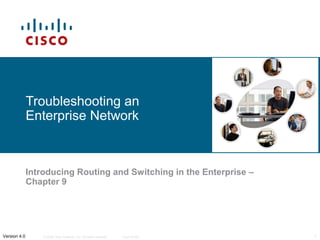
CCNA Discovery 3 - Chapter 9
- 1. Troubleshooting an Enterprise Network Introducing Routing and Switching in the Enterprise – Chapter 9 Version 4.0 © 2006 Cisco Systems, Inc. All rights reserved. Cisco Public 1
- 2. Objectives Explain the importance of uptime and the types of issues that cause failure. Isolate and correct switching problems. Isolate and correct routing issues. Isolate and correct WAN configurations. Isolate and correct ACL issues. © 2006 Cisco Systems, Inc. All rights reserved. Cisco Public 2
- 3. Explain the Importance of Uptime and the Types of Issues that Cause Failure Reduction in uptime can have a negative impact on a business Downtime results in lost productivity and customer frustration © 2006 Cisco Systems, Inc. All rights reserved. Cisco Public 3
- 4. Explain the Importance of Uptime and the Types of Issues that Cause Failure Ways to ensure uptime: Proactive maintenance Network monitoring © 2006 Cisco Systems, Inc. All rights reserved. Cisco Public 4
- 5. Explain the Importance of Uptime and the Types of Issues that Cause Failure Failure domain: area of the network affected by the failure or misconfiguration of a network device Troubleshoot resources with a larger failure domain first, unless another problem is business critical © 2006 Cisco Systems, Inc. All rights reserved. Cisco Public 5
- 6. Explain the Importance of Uptime and the Types of Issues that Cause Failure Troubleshooting approaches: Top-down Bottom-up Divide and conquer Trial and error Substitution © 2006 Cisco Systems, Inc. All rights reserved. Cisco Public 6
- 7. Isolate and Correct Switching Problems The most common problems with switches occur at the Physical Layer © 2006 Cisco Systems, Inc. All rights reserved. Cisco Public 7
- 8. Isolate and Correct Switching Problems Suboptimal switching can be traced to STP problems Determine the VLAN assignment of non-functioning ports Verify the trunking protocol if inter-VLAN routing is required © 2006 Cisco Systems, Inc. All rights reserved. Cisco Public 8
- 9. Isolate and Correct Switching Problems Verify VTP domain name Verify identical revision numbers on all devices Verify identical VTP versions on all devices © 2006 Cisco Systems, Inc. All rights reserved. Cisco Public 9
- 10. Isolate and Correct Routing Issues Determining and correcting RIP issues: Compatibility between RIPv1 and RIPv2 Missing or incorrect network statements Errors in interface configurations © 2006 Cisco Systems, Inc. All rights reserved. Cisco Public 10
- 11. Isolate and Correct Routing Issues Determine and correct EIGRP issues: Mismatched AS numbers Errors in network statements Errors in interface addressing Auto-summarization used with discontiguous subnets © 2006 Cisco Systems, Inc. All rights reserved. Cisco Public 11
- 12. Isolate and Correct Routing Issues Determine and correct OSPF issues: Mismatched authentication or timer intervals Errors in wildcard masks or network statements Errors in interface configurations © 2006 Cisco Systems, Inc. All rights reserved. Cisco Public 12
- 13. Isolate and Correct Routing Issues Determine and correct route redistribution Verify that users on internal routers can access external networks © 2006 Cisco Systems, Inc. All rights reserved. Cisco Public 13
- 14. Isolate and Correct WAN Configurations Determine and correct WAN Physical Layer connection issues: Clocking Cable types Loose or faulty connectors © 2006 Cisco Systems, Inc. All rights reserved. Cisco Public 14
- 15. Isolate and Correct WAN Configurations Determine and correct WAN Data Link Layer and Network Layer connection issues: Encapsulation mismatches Incompatible formats IP addressing errors © 2006 Cisco Systems, Inc. All rights reserved. Cisco Public 15
- 16. Isolate and Correct WAN Configurations Determine and correct authentication issues © 2006 Cisco Systems, Inc. All rights reserved. Cisco Public 16
- 17. Isolate and Correct ACL Issues Verify network connectivity before an ACL is applied Enable logging © 2006 Cisco Systems, Inc. All rights reserved. Cisco Public 17
- 18. Isolate and Correct ACL Issues Determine and correct ACL configuration and placement issues: ACL statements should permit highest volume traffic early in the ACL Implicit deny may have unintended consequences Improper ACL placement may waste bandwidth © 2006 Cisco Systems, Inc. All rights reserved. Cisco Public 18
- 19. Summary Adherence to the three-layer hierarchical network design model assists in troubleshooting When troubleshooting a network, determine the scope of the problem and isolate the issue to a specific failure domain. The most common problems with switches occur at the Physical Layer. Use debug commands to isolate problems, not to monitor normal network operation. When troubleshooting PPP, verify that the LCP has been opened, authentication and NCP completed. ACLs can create complications in network operations. © 2006 Cisco Systems, Inc. All rights reserved. Cisco Public 19
- 20. © 2006 Cisco Systems, Inc. All rights reserved. Cisco Public 20
